Table of Contents[Hide][Show]
*21 Day Lower Blood Sugar Challenge™: Your challenge task is at the bottom of this page.
Regardless of where you live around the globe, we’re all familiar with the food pyramid, right?
It’s a picture we’ve all grown up with that supposedly represents all the “healthy” foods we’re meant to eat and in what quantities.
When we think about it, we assume that large health organizations have our best interests at heart, right? After all, they want us to be healthy – at least, that’s what we assume.
However, as it turns out there is a bit more to the story… a few surprising things in fact…
Here we’ll explore a few myths, along with sharing a new diabetes food pyramid that will help you achieve better blood glucose control.
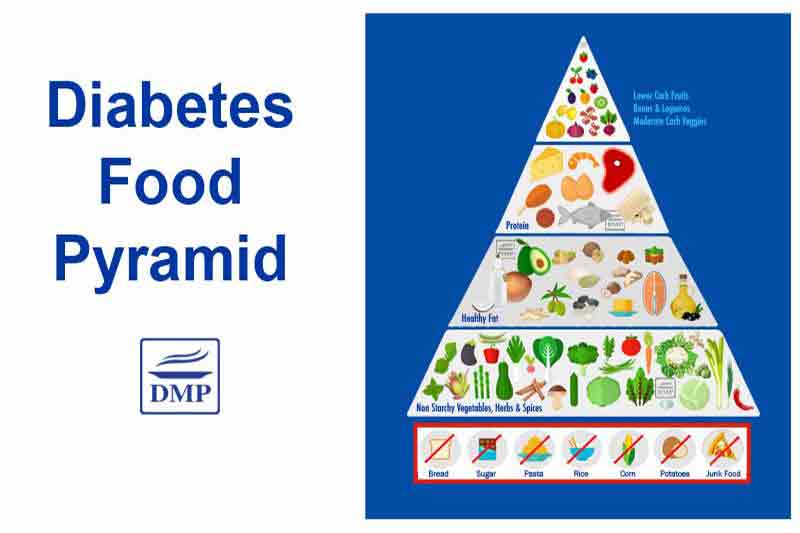
The Lies Behind Food and Health Promotion
Transnational Corporations Now Dominate the Food Supply
It’s no secret that in the past few decades food has been transformed by multinational ultra-processed food and fast food, taking over the globe.
Alongside these changes we’ve seen an increase in obesity, type 2 diabetes, cardiovascular disease and cancer – and that’s no coincidence.
The fact is that transnational corporations (selling unhealthy commodities) are major drivers of the global epidemics that we are currently experiencing.
People always try to say: “it’s the individuals problem. Individuals have a choice.”
While this is true to some extent, when individuals are surrounded by ultra-processed food and fast food at every single turn, this is not your fault. This is not an individual issue.
This is a societal issue, a social issue and a global issue that no one has the power to tackle.
Why?
Because transnational corporations have billions of dollars to back their pursuits of making even more money. These companies have literally taken over our food supply, pushing aside the importance of fresh food, and even pushing aside and dominating above public health priorities – sad but true.
Nutrition Myths: The Fat & Sugar Debate
For years we’ve been told to eat a low fat diet to prevent heart disease. And to avoid fat because it clogs the arteries and leads to weight gain.
“The premise that high fat diets are bad for you is completely wrong,” says Dr. Adam Splaver, Cardiologist from NanoHealthAssociates. “This all stems from an erroneous study called the Seven Countries Study performed by Ancel Keys, a Minnesota physiologist.”
“In that study, he correlated a high fat diet with a higher risk of cardiovascular disease. However, the study itself included more than 30 countries and Dr. Keys cherry-picked the data to fit his premise. When you look at the data in totality it was a higher carb diet that correlated with a higher risk of cardiovascular disease.”
And indeed, as research on fat, sugar, carbohydrates and heart disease has evolved, it keeps becoming clearer and clearer that fat is not the problem. Refined carbohydrates, sugar and excessive amounts of carbs are all greater contributors to the development of heart disease.
Guess where we predominantly find refined carbohydrates, sugar and excessive amounts of carbs?
In ultra-processed foods and fast foods (made by multinational food companies) that line almost every grocery aisle in the store!
This is just one practical example of nutrition myths that now pervade our society.
Corporate Sponsorship: Health Organizations and Dietitian’s Associations
It’s a sad but true fact that many health organizations have based their information on this old research, that has now increasingly being proven wrong.
Not only that, organizations are frequently sponsored by large multinational food companies. And in various ways, these corporations control what is considered “acceptable” mainstream nutrition knowledge that gets distributed to the public (they have multi-billion dollars more to invest than any public health campaign).
For instance, the Academy of Nutrition & Dietetics is sponsored by:
- Abbot Nutrition
- National Dairy Council
- Campbell Soup Company
- Ingredion
- Lentils.org
- Premier Protein
- SPLENDA
- Sunsweet Growers
In recent years, this list has greatly improved but used to include the likes of Coca Cola, Kellogg’s and Pepsi Co. Likewise the American Diabetes Association sponsors have somewhat improved in recent years.
Dietitians Association of Australia is sponsored by:
- Nestle
- Campbells
- Meat & Livestock
- Jalna yogurt
- Arnott’s
- The Australian Breakfast Cereal Manufacturers Forum
All big businesses crossing transnational borders.
While it’s understandable that organizations often do need corporate sponsorship, the ethical standards of selecting those sponsors has often been questionable. After all, there are plenty of ethical, natural food companies that would make for better nutrition/health partners. And over the years, this lack of selectiveness has also raised questions as to how much influence these companies have over health organizations.
It should also be noted that food companies (often the undesirable ones) are constantly funding nutrition research, which at the end of the day, experts claim is full of bias and cherry-picking of data.
This stuff goes on behind the scenes, and granted, years ago organizations could get away with a lot more than they can now. With the advent of the internet and access to more information, savvy researchers and experts worldwide continue to uncover the undercurrent of corporate connection that runs through many of these nutrition/health circles and the research ‘facts’ they present.
The point of all this is: always question.
Do your homework and keep an open mind because things are not always what they appear to be on the surface.
Okay, enough said.
Now let’s move onto exploring diabetes food pyramids.
The OLD Diabetes Food Pyramid
United States
The food pyramid most of us know looks something like this:
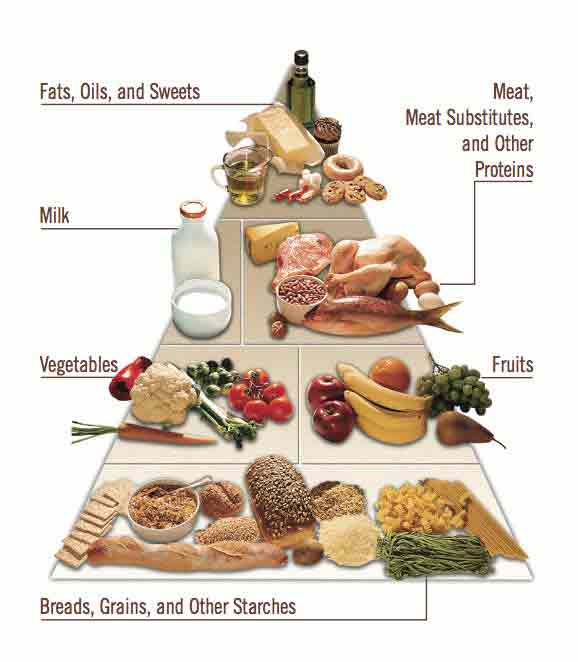
The above pyramid has been used for years by the American Diabetes Association to promote “healthy” diabetic eating, to guide the eating habits of the overall population. And this food pyramid is pretty consistent for dietary guidelines worldwide.
It has long been based on the following food groups:
- 6-11 servings of grains and starches per day
- 3-5 servings of vegetables
- 2-4 servings of fruit
- 2-3 servings of milk
- 4-6 oz of meat and meat substitutes
- Fats, sweets and alcohol should be a special treat
The serves of grains and starches has become a little less in recent years, but is still promoted as the predominant “base” of most healthy diets.
Australia
Australia updated their food pyramid a couple of years back, which did make some improvements, shifting grains and starches up the pyramid and putting vegetables in the spotlight.
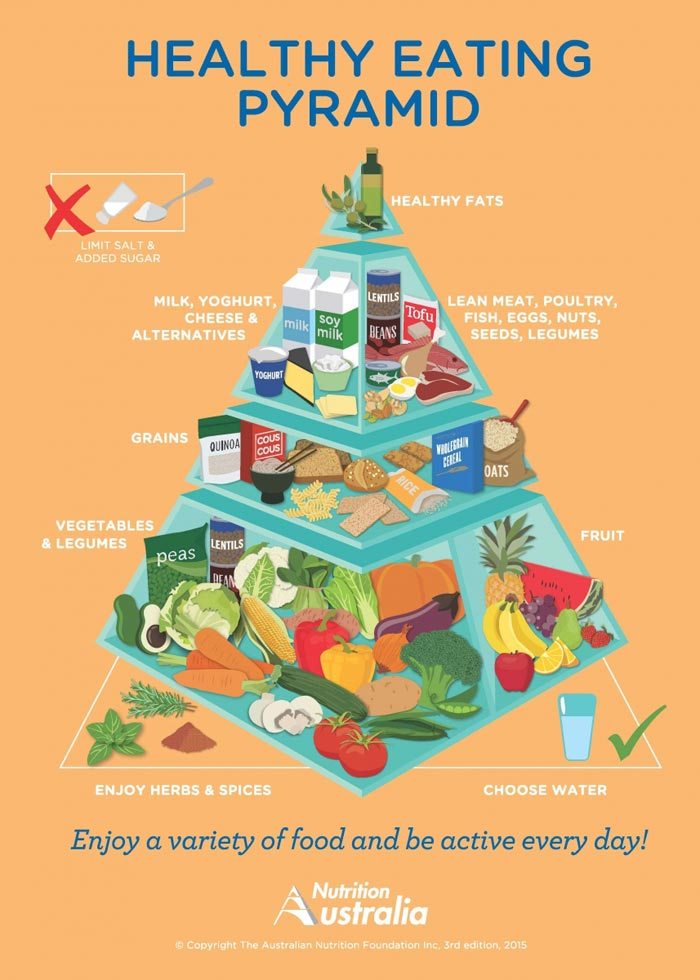
Ireland
Ireland also updated their food pyramid in a similar fashion to Australia.
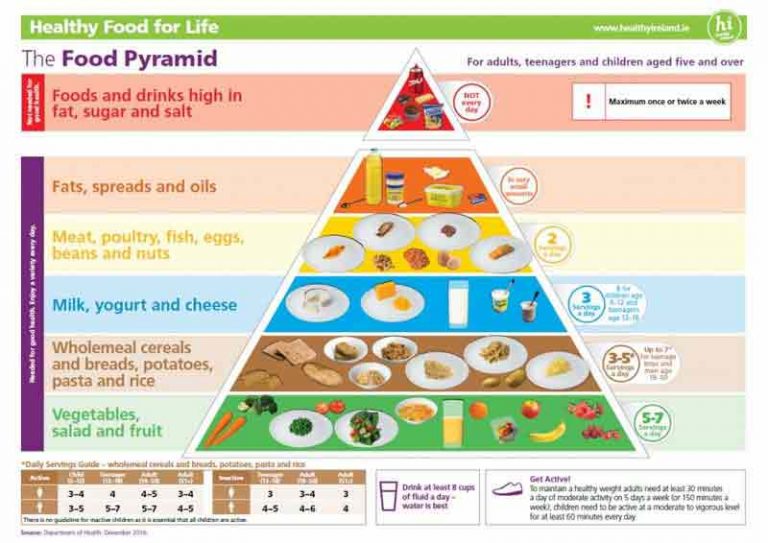
UK
The UK now have a round image, rather than a pyramid, but it’s still based on OLD nutrition data with the inclusion of ample carbohydrates.
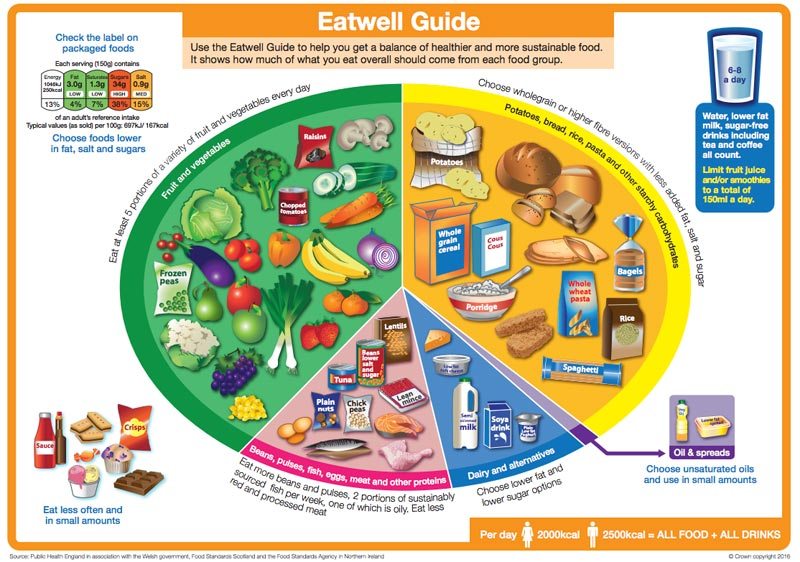
- Eat at least five portions of a variety of fruit and vegetables a day
- Base meals on potatoes, bread, rice, pasta or other starchy carbohydrates. Choose wholegrain where possible
- Have some dairy or dairy alternatives. Choose lower-fat and lower-sugar options
- Eat some beans, pulses, fish, eggs, meat and other protein. Aim for at least two portions of fish every week
- Choose unsaturated oils and spreads and eat in small amounts
- Eat foods high in fat, salt and sugar less often and in small amounts
Many of these food pyramids try to emphasize portion sizes, which is an important factor – we are definitely eating more than we once were.
Canada
Canada doesn’t have a “pyramid” as such but is still promoting the same outdated information from 2005!! – yes, you read that right, info from 2005!
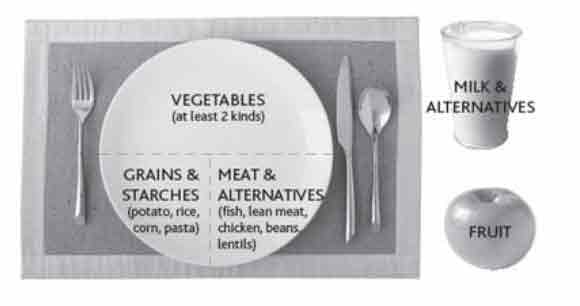
And it gets worse… even their professional resources are from 2005 and they are still recommending professionals purchase a nutrition book written in 2005!
It’s now well over a decade since that date – that’s pretty darn disgraceful.

Major Problems with the OLD Food Pyramid
Here at DMP we encourage a lower carb whole foods diet, quite simply because current research shows it’s a great dietary pattern for improving blood sugar and A1c – meaning, it’s a great diet to treat type 2 diabetes and prediabetes!
The experiences of our members and subscribers (who are getting awesome results) also demonstrates that the research is spot on. It is possible to lower your blood sugar and A1c and reverse the body’s metabolism so it gets back to, or close to normal once again.
And in fact, when you’re eating right, results can occur quite quickly.
Here’s what Gloria G (a VIP Member) said in a comment recently:
“I just wanted to share my great results having been on this plan for only one month. 3 months ago my A1C was 8.7 and my recent blood work showed it at 7.4. My endocrinologist was very impressed and thinks I will be at the target level by my next testing in 3 months. I am excited to continue on this plan and maybe I can stop one of my injections. Thank you for your dedication to diabetes research and food plans.”
Yep, better A1c in one month! Members are often experiencing these type of results.
But unfortunately, following the old food pyramid is probably not going to help you achieve this – at least that’s what our experience (and the research) shows.
So what’s wrong with the OLD food pyramid?
Quite a few things…
Grains & Starches
In a lower carb diet, all grains are excluded and so are most starches.
Why?
Because they are very high carb foods and carbohydrates are the single biggest factor that increases blood sugar and A1c. You cut down on the high carb foods and you’ll see your numbers going down.
There’s also no evidence to show that grains, even whole grains, help with blood sugar control.
The American Diabetes Association (ADA) still encourage 25% of your intake should be ‘grains & starches’ and list ‘whole grains’ as one of their diabetes “superfoods.” And as we just saw above, so do most of the other large health organizations.
However, the ADA’s recommendations are a bit contradictory to what they state in their 2017 Standards of Medical Care in Diabetes, that: “whole-grain consumption is not associated with improvements in glycemic control in type 2 diabetes.” Or in other words, it doesn’t help you regulate blood sugar and A1c – that’s what the research clearly shows.
Here’s the thing… whole grains are definitely a better choice of food compared to white/ refined grains. They are a complex carbohydrate, they contain more fiber, they fill you up for longer, they are often lower glycemic index, and they are “generally” a healthier food.
But, they do not help with diabetes TREATMENT – prevention for the general population, yes. But treatment, no.
Treatment of a condition and prevention of a condition occurring are two completely different things.
Some people may be able to eat whole grains, portion controlled. But most people with type 2 diabetes and prediabetes will simply do better without them.
Fruit
While fruit is a natural food that is generally considered healthy. When you have blood sugar issues, fruit can also be problematic.
Why?
Again, many fruits are very high in carbs and will raise blood sugar more than you need them to. There are some fruits that are better options than others (keep reading to discover them below).
Fats
Compared to other macronutrients (carbs and protein), fats influence blood sugar the least.
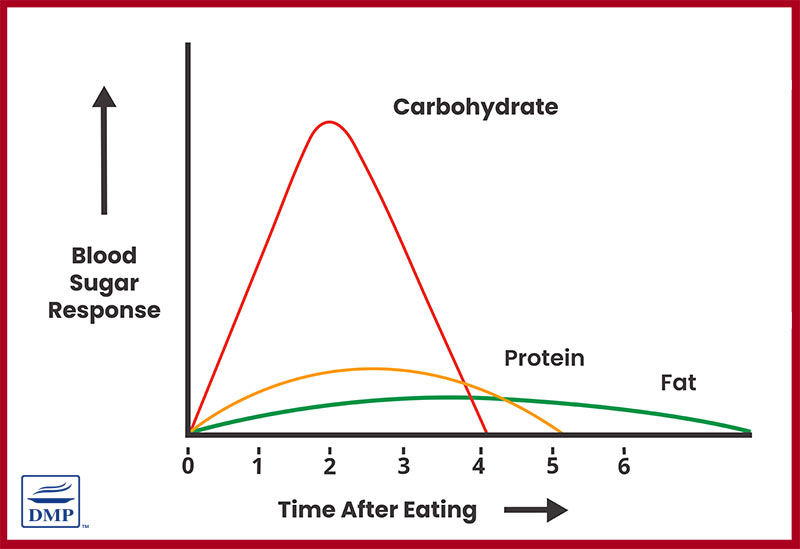
Many of us have the “low fat” idea still stuck in our heads because eating “low fat” is something that’s been hounded into us for many years.
However, while people may have various “opinions” about fat, choosing to believe myths is not something we do here at DMP.
Instead of regurgitating the same outdated information, our goal is to share the most recent scientific evidence so you understand the facts so you can determine the truth and therefore, make more informed decisions about your health.
Much research in recent years has concluded that fat is not the enemy, even saturated fat. In fact, fat is something we absolutely need.
And despite commonly held assumptions, eating fat does not make you fat, does not necessarily raise cholesterol, and in fact, can be heart protective, lower cholesterol, aid insulin resistance, decrease inflammation in the body, and even assist with weight loss.
Additionally, the type of fat promoted by health organizations (unsaturated margarines and low quality oils like soy, peanut, vegetable) are high in omega-6, and have been shown to contribute to health problems, not help them. Some products promoted as healthy also contain trans fats, which are damaging to our health.
We’ve covered the topic of fats in detail over here, so we won’t delve any further into this now.
Your New Diabetes Food Pyramid
We’ve taken the liberty to develop a new diabetes food pyramid.
Please share it around to help others – thanks!
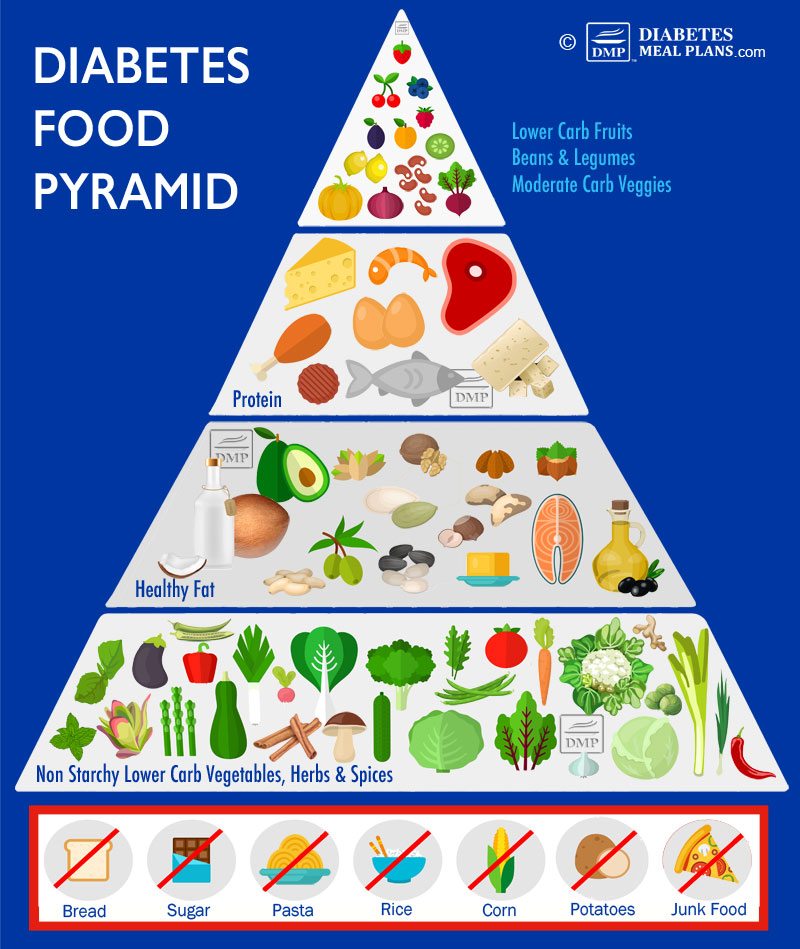
It is based on ample current research that we have evaluated, showing the best foods/diet to help treat type 2 diabetes and prediabetes – a low carb diet filled with natural whole foods!
Vegetables, Herbs & Spices
By volume, non-starchy vegetables should make up the largest proportion of your diet.
Vegetables like: asparagus, bell pepper (capsicum), bok choy, broccoli, Brussels sprouts, cabbage, cauliflower, celery, and the list goes on.
Most scientific evidence (and most nutrition experts) agree that vegetables are a super healthy food.
Even Dr. Splaver (cardiologist) revealed that in terms of heart health, veggies are right up there!
Overall they provide fiber, vitamins, minerals, phytonutrients, flavonoids, and they are relatively low in carbohydrates, which makes them great for blood sugar and A1c control and for boosting overall health.
Fresh or dried herbs and spices also offer excellent health-boosting properties, not to mention adding natural flavor to all your low carb dishes!
Healthy fats
A higher fat content in your diet is a natural consequence of lowering carbs.
For instance, if you take away high carb foods like bread, pasta, rice and potatoes, you suddenly have a calorie deficit. You can increase the amount of vegetables you eat but they are relatively low in overall calories. And you don’t want to eat excessive amounts of protein.
So the natural consequence is that you eat more healthy fat sources. That doesn’t mean load up with bacon and pork rinds as you might see on other low carb recipe sites, we certainly do not suggest you do that.
But increase your intake of healthy fats like nuts, seeds, olives, avocado, coconut oil and olive oil – fats with proven health benefits.
Protein
Protein helps keep us full and satisfied for longer.
You can eat all types of meats, poultry, fish, and seafood. Many experts still agree though, that choosing lean meats is best.
And you can select from a large range of dairy products (both a protein and fat) like cheese, feta, and ricotta, along with eggs – all of which are healthy nutrient-dense foods.
Fruit
We all need some sweetness and the good news is, you can include lower carb fruits in your diet on a regular basis.
For instance, berries (strawberries, blueberries, raspberries), apricot, lemon, lime, passionfruit, peach and plum are all good choices.
Whereas apples, bananas, oranges, pears, watermelon etc, are higher carb fruits that make it more difficult to regulate blood glucose levels. That goes for canned fruit too, as it often also contains added sugar.
And fruit juice is just like drinking pure sugar, so you’re best to steer clear of it.
Moderate Carb Veggies
Things like pumpkin, carrot, and beets are a little higher in carbohydrate content than things like broccoli and cucumber but they are not so high that they need to be avoided all together.
Beans & Legumes
Many people think these are a protein food. And they certainly do contain protein.
However, beans and legumes are also high in carbs, so for most people, they need to be portion controlled. And some people will need to exclude them altogether.
For those of you that can tolerate them, they do provide great benefits in terms of their dietary fiber, particularly soluble fiber, and in their resistant starch, which is beneficial for feeding gut bacteria.
Treats
Sugar-filled treats like ice cream should be kept to a bear minimum – we’re talking the odd occasion. And if you can, you’re better off eliminating them altogether and making your own treats from the foods listed above, with the addition of sugar substitutes like stevia, monk fruit, erythritol, vanilla and so forth.
The same goes for treats like fried foods and processed foods – better kept off your list or to a bare minimum.
Grains & Starches
Should be eliminated or kept to a bare minimum, which is why you don’t see them in the ‘new’ diabetes food pyramid.
You can find more info on whole grains here and starches here.
The Wrap Up
Just because you read something online, even on large health organization websites, does not mean it is true.
There are many nutrition myths that pervade our society and as new research continues to unfold, we are learning that much of what has been sold as “healthy” is in fact, not-so-healthy, especially when trying to TREAT a condition.
Remember, prevention and treatment are not the same thing.
In terms of the research we’ve done (and have been doing for years), the above NEW diabetes food pyramid covers the ‘safe’ foods with proven benefits for type 2 diabetes and prediabetes treatment. And there are plenty of delicious foods that can be eaten.
Though there are plenty of food choices available to you, if you’re used to eating everything out of a packet, eating fresh can be different. That’s where our weekly meal planning service can help.
We send our members easy (and delicious) blood sugar friendly menus, along with regular cooking classes – all of which is designed to help you eat to treat your type 2 diabetes and prediabetes (if you choose to join sometime).
One thing is clear: if you’re struggling to get your blood sugar levels within a healthy range, think about which diabetes food pyramid you’ve been following. Perhaps it’s time to make a few changes to your meal plan. You never know, you might just be surprised when you do!
YOUR TASK: 21 Day Lower Blood Sugar Challenge™
- Examine your eating routine – have you been eating closer to the old food pyramid or the new food pyramid? Take note of the things that you can work on changing during the 21 day challenge. Make a list – it always helps to write it down – makes it more real, rather than just being in your head.
- Follow this food list – (note: we sent a downloadable version to your email) your one focus and goal over the next 21 days is to follow our recommended food list as closely as possible. Don’t worry about calories (for now), just focus on eating nothing else but the foods on this list. NOTE: Please check your email because we sent you a pdf copy of this list to your inbox.
- As we talked about yesterday, cut out sugar, bread, potatoes, pasta, cereals, and rice – if you’ve been eating these foods as staples (and many of us do), this is a big task but will bring about dramatic results. NOTE: For those with very high blood sugar numbers (200+/ 11+) you may need to cut back over a few days to week, instead of cutting out all in one go. Why? Because you can feel shaky, dizzy, and nauseous. These are similar symptoms of hypoglycemia (low blood sugar). It’s likely that you don’t actually have hypoglycemia but because your levels have been high and you’ve been eating carbs, you can get similar symptoms when cutting them out – just be aware and monitor yourself.
Commit to yourself and apply what we share because we know what we share can help you get results.
Thanks for being involved – it’s great to have you on board!
Need extra support during the challenge & beyond? Join us as a member.
You’ll receive weekly meal plans and exclusive member benefits.

TESTIMONIAL:
Gloria G, VIP Member, says: “3 months ago my A1C was 8.7 and my recent blood work showed it at 7.4. My endocrinologist was very impressed and thinks I will be at the target level by my next testing in 3 months. Just eating your meal plan for a month and seeing the results gives me motivation to continue. Thank you for your dedication to diabetes research and food plans.”

Traci Waggoner
This article has been very helpful.
Elliot
I usually love your stuff, but this particular article would have been much better if you’d put the Diabetes Meal Plan pyramid at the top and then gone into the explanation. The way it is written was confusing making me initially think the other pyramids (Ireland, etc.) following the u.s. pyramid were what you were recommending…
Pedro
Just started though I have been following the meal plans, sort of, for over a year. Bs 7.7 this morning, which is good for me. I have to sit with the list and get ready for shopping as I do not have all the veggies.
Jedha: Nutritionist (MNutr)
Great to have you here Pedro. And sort of following the meal plans for a year is common, sometimes it takes a while to take things on and change habits but the important thing is to take steps forward each day. Thanks for checking in and look forward to updates.
Kuldip kaur
Hi I am checking in for day 2
Jedha: Nutritionist (MNutr)
Thanks Kuldip – hope all is going well!
Beth
Just checking in – low carb breakfast and reviewing the documentation provided. I enjoyed some cinnamon tea last night too.
Jedha: Nutritionist (MNutr)
Sounds like you’re doing great Beth, thanks for checking in.
Nancy Puckett
I am a type2 diabetic with 1 kidney due to cancer. Don’t know what to eat but I have to be on1500 calories a day . I am ready to cry ,nerves are shot !Can you help me find a diet to loose weight! i weigh298 and am5,6″ .
thank you ,
Nancy Puckett
Jedha: Nutritionist (MNutr)
Hi Nancy, check out our recommended food list here.
Chris Barratt
As a Canadian, it is incumbent upon me to bring to your attention the inaccuracies regarding The Canada Food Guide that appear in this article. I invite you to view the information I have provided and hopefully use it to update the information presented here.
JD admin
Thanks for your comment Chris – this article was first written in 2015 so has not yet been updated. We thank you for providing the information to help us do this when we have time.
Linda Norris
Is this free?
Ginger
Day 11 Nov 25th
FBS this a.m. was 5.9🤗🤗🤗…seeing progress with positive changes these past 11 days…personally learning and applying information provided is helping immensely as I also do follow the links for further discussion and info, so appreciated…you are all amazing providing this 21 day challenge , the accountability helps me a lot too in checking in too…
Blessings
Ginger
Jedha: Nutritionist (MNutr)
So glad you’re enjoying it and applying too! Thanks for checking in
Roseanne
Hello,
Just getting started…lol.
neil
lots of interesting information to go through, all good.
Miriam
Checking in. Things are going well. FBS down several points. Wt. down 2 lbs. Trying to get in the habit of more frequent bs monitoring to see how the foods I’m eating impacts the numbers.
Miriam
Having problems printing out desired info , like the new food pyramid. It doesn’t fit on one page, rather is broken up btw two. Plus much of the printed word is not printing out legibly. What can your web master do to improve these issues?
Selene Cohen-Zuyus
Since I joined in August my a1c1 went from 7.0 to 5.8 in 3 months. I have changed the way I eat . And I lost 24 lbs. !!! Thank you !!! Please keep posting recipes!!
Jedha: Nutritionist (MNutr)
That’s fantastic Selene – we’re so glad you joined us as a member!
raani
Yes, this program brings to the surface. I over eat; so much of a habit I can’t tell when I have overdone – .
I am small, thin. I have been mostly eating a low carb diet. any suggestions for gaining weight.
I live in the Himalayas which presents a whole list of what I wan’t eat – no eggs; times of the year fresh produce is scarce – so many potatoes types.
when I am in the west there is so much choice.
Thanks for your help.
Susan
Checking in. This morning I’m having tea with cinnamon as suggested yesterday. I’ve just printed out the food list, I’ll study it before making my grocery list for the week.
Karen
Excellent information! I totally agree. I am going to tell my diabetic parents to check out your website! Love your simple pyramid. Very clear and easy to understand.
Jedha: Nutritionist (MNutr)
Thanks Karen. Glad you enjoyed it and hope your parents come along to check it out.
Felis
Canada has a new food guide if you are looking to update your article. Although whatever you posted previously is not the offical guide either
Tracy Hudson
Hi! I am so pleased to have found your website as a newly diagnosed T2 (two weeks ago). I was told by my GP to make an appointment with the diabetic nurse, and I am two weeks away from my first appointment with no help and support, apart from being given metformin, and being advised to up it weekly till I’m taking it three times a day. I have been finding that through fb support groups (my only current place for advice), I have benefited from other people’s experiences and their advice has been invaluable. I am however, struggling would a few issues. Firstly, I basically went cold turkey as soon as I received my diagnosis, along with the knowledge I was menopausal 😏 I noticed I have been increasingly fatigued, tired and listless, and had hardly any energy in the mornings. I felt floaty, and have had a couple of panic attacks, one so bad I thought I was having a hypo (through inexperience and lack of knowledge). I have been checking my blood sugar and it has been between 4 and 8 most of the time. Sorry for going on. I would like to know what you suggest for energy in place of carbs? I have been having eggs in the morning, but apart from the fact they are protein(?) I know they are a natural binder, and as a result, I have not had a bowel movement in about a week. I am unsure what I should do and eat to kickstart it again, so would very much appreciate your advice. Tia. X
Emily - Dietitian (MS, RD)
You’re come to the right place for some information. As you can tell from this food pyramid we encourage lots of protein and healthy fat, and allow the vegetables and dairy to account for all our your carb intake.
You could be feeling fatigued because you’re body is still adjusting to this new way of eating, but that does not mean you need to “replace” the carbs with anything. You should still be able to consume sufficient calories (energy) from vegetables, protein, and fat. If you’re concerned you are not eating enough calories then I would suggest keeping a food log for a week so that you can confirm your intake. Adding extra fats can be an easy way to up the calories if needed.
As far as constipation, again your body is probably just adapting to your new way of eating. Make sure to drink ample amounts of water. Water is what flushes everything!! You also need to consume adequate fiber each day, which is achieve by eating lots of vegetables, nuts, and seeds. If constipation persists you need to speak with your doctor ASAP to ensure there is not anything else going on medically.
Tanya Bennett
If I only knew some of this information a year ago I would no longer be pre-diabetic. Upon waking my blood sugar is 82. At lunch it is 99. At dinner it is 111. At bedtime it is115. I cannot eat after 6:00pm without my blood sugar going up. What can I eat before bed? I am super active and stay up late. I will try to watch my carb intake.
Jedha: Nutritionist (MNutr)
Glad you enjoying the info. If you get hungry you could try fat or protein based foods like cheese, cottage cheese, chicken, avocado etc.
Iiz
I am so enjoying this challenge.it makes me aware of my responsibility in this challenge.today my fasting number was92
Jedha: Nutritionist (MNutr)
Great to hear Liz. Thanks for checking in!
Pat Odoms
Late start this morn, did not sleep well. BG 99 at 10:15AM. Fix 100% sugar free whey protein smoothie with 1/4 cup strawberries, pinch of Sweet Leaf stevia and 1 cup vanilla almond milk about 24g. Lunch was sushi, wonton soup and shrimp with lots of veggies & a little pasta, dessert strawberry & vanilla ice cream total 1 cup at 2PM. Guessing 220g. BG check at 4:51PM 126. Sunday after church is Asian buffett day. I custom pick ingredients for a stir fry and load up on veggies.
Emily - Dietitian (MS, RD)
Pat, make sure to read over the food list we included in this mornings email. Although it might seem like you’re just having a “little” pasta and a “little” dessert, when you add all these things up throughout the day it can easily push you over your daily target. I hope you continue to check-in with us over the next 21 days and continue to make small adjustments for a healthier you!
Marie
Glucose at 114 on waking. Woke up later than usual. Just had breakfast, two eggs and a drip of bacon, black coffee and a half a glass (4oz.)of milk.
Marty
My morning glucose today was 111, down considerably from Day 1, thanks to closet watching of carbs, etc. Are protein shakes good/bad? I have been using Amplify protein powder with berries and almond milk. It doesn’t seem to spike my blood sugars and keeps me full until lunch.
Emily - Dietitian (MS, RD)
Protein shakes can be a good addition to your diet, IF you are picking the right protein powder. You want to look for something that is low in carbs, free of any artificial sweetener, and has a relatively short ingredient list. Check out this article for some Tips to Choosing a Protein Powder that’s Diabetes Friendly.
Marty
Thank you so much for your quick reply! I plan to try the peanut balls too!
Heidi
The peanut butter balls are amazing!! One of my favorite snacks
Jedha: Nutritionist (MNutr)
Yes they are Heidi – glad you like them ;)
Jedha: Nutritionist (MNutr)
Great to see you’re already noticing the difference Marty – keep on going!
Pat McElveen
I clicked on your protein balls and they look good and quick to make. Is there any special protein powder that you recommend?
Emily - Dietitian (MS, RD)
When searching for a good quality protein powder you want to find something that is low in carbs, does not use artificial sweetener, and has a relatively short ingredient list. Check out this info for some suggestions!
Clara
Hi all. I am an ardent reader of Jedha’s diet plan. Every e-mail I receive from Jedha on diebetese diet, I ensure follow a part of it for my daughter who is 17 years old and has diabetese for the past 4 years. My daughter has stopped taking milk instead takes yoghurt and butter milk. Milk spikes her sugar. She takes insulin 30 minutes before b/fas, lunch and dinner and with her diet, her sugar level comes to 140 to sometimes 109. Her recent A1C was 7.5 which is comparatively good. London Dairy ice cream agrees very well with her at night after dinner. We have switched on to Pure coconut oil for all our cooking and her cholestrol level amazingly fanatastic. She takes one cup of rice only in the afternoon. Some of the fish, spikes her sugar.
I wanted some recipes for baking pizza and bread for diabetic patients at home as she craves to eat it and at time I allow her to eat it generously and after two hours her sugar levels shoots up.
Also please note that pure (I mean simply pure – yellow in color) cow ghee is one of the best medicine I have tried on her to bring her sugar down without medicines. However you need to exercise after having a tea spoon of ghee early morning (do not take more than that).
Emily - Dietitian (MS, RD)
I am glad that you and your daughter are finding Jedha’s information helpful. We have a low carb cauliflower pizza crust recipe that I hope you will be able to try- make sure to let us know how it turns out.
You can find some information about bread over here. This article includes several suggestions for lower carb breads that won’t spike her sugar. Another suggestion for you is to consider our Bread Masterclass Program; by joining you will receive recipes to over 30 low carb bread recipes.
Jedha: Nutritionist (MNutr)
So glad the info we share is helping to make a difference in your daughters life Clara. Keep up the great work!
Donna
I can’t find the date this article was written, but I went to a (Canadian) diabetes dietitian yesterday (Sept 28, 2018) to learn about my disease. The Canadian food pyramid you show is nothing like what the dietitian showed me. I’ll give you the benefit of the doubt and perhaps it was updated since you wrote this article, however you might want to update this to reflect what is actually being taught. It’s not so much of a “pyramid” as it is a “rainbow”.
Emily - Dietitian (MS, RD)
Hi Donna, we will have to look into it. Thanks for the heads up!
Jon Jacobsen
I try to stay in ketosis, keeping my carbohydrate intake under 40 grams/day, constant blood monitoring 4 glucose level, and checking blood ketones. is this diet aligned with my strict keto diet?
using keto diet: is A1C was 12.6 18 months ago and today it’s under 6. I would like to add some variety to my diet like the recipes in your plan, but I am concerned you don’t go strict enough.
Jedha: Nutritionist (MNutr)
Hi Jon, our diet plan is low carb, not keto. In our experience, members are getting the same results without needing to be so strict with cutting carbs. And as you say, we also found, having more variety helps people sustain a good eating plan long term. We also believe more vegetables in the diet is important. We certainly don’t go so strict, so in the end, the choice to join as a member is yours.
Janet
Is there a downloadable version of your pyramid? It would be handy to have hanging on my fridge.
Jedha: Nutritionist (MNutr)
Not yet Janet, but we’ve had a couple of requests so we will work on it and let our subscribers know when it’s available.
Janet
Thnx so much. That’s great to hear.
Dave
Where does greek yogurt fit in pyramid?
Should it be low fat or full fat?
Any limit on amount per day?
Emily - Dietitian (MS, RD)
Full fat is perfectly acceptable, although by nature most brands of Greek Yogurt are lower in fat- so whatever is easiest for you to find is great! You’re best bet is to pick the plain flavor, and add your own fruit and nuts for flavor. You can always use something like stevia and cinnamon to sweeten.
I would place yogurt towards the top of the pyramid- somewhere between the protein and higher carb veggie sections. Aim for just one serving per day!
Meg
Diet clubs have never worked for me, I have always believed in “everything in moderation.”
That being said, I see that chocolate is in the “no zone?” My physician told me “Dark chocolate is perfectly fine!”
Emily - Dietitian (MS, RD)
The problem with “everything in moderation” is two-fold. First, most people cannot just eat something (such as dark chocolate) in moderation. A serving of dark chocolate is often just one small square, but once you take the bar of chocolate out it’s likely that you’ll have several pieces. Secondly, when you eating something in moderation, especially something that contains sugar, you are constantly igniting the natural “sweet tooth” we all have. This will make you crave sugary foods more often and thus makes “eating in moderation” a lot harder!
If you are truly diligent with your dark chocolate, then it is okay to have as a treat on occasion- you can find out more information about chocolate over here. But be realistic with yourself and don’t let a treat become an everyday indulgence.
Cynthia
Hi – what is your opinion on foods like Alpro plain ‘yogurt’? As a vegetarian, I like the extra protein but I find I am hungry again a little while after eating. Even with fruit and bee pollen, I am looking for a snack!
Emily - Dietitian (MS, RD)
You’ve come to the right place because we have tons of ideas for low carb, healthy snacks! I’m not familiar with the Alpro ‘yogurt,’ more importantly than checking the protein, I would check the carbohydrates per serving and make your decision based off of that. Have you read this article yet about what to eat on a vegetarian- diabetic friendly diet?
Ed Wilde
I need a simple meal plan for a month
As my type II is getting worse cause of not lousy foods but mismanagement of proteins and fats and fruits and vegetables I’m trying to find the right combination to level my intake of foods
That reflect my sugars.
Jedha
We have great weekly meal plans, but you can also find a 2 day sample menu here Ed. If you follow this food pyramid as a guide on the types of foods to choose, you should find things fall into place a bit more.
deni
a.where does red wine fit? of course alcohol is bad but it works for me and french/italians. what say?
b. also, there is evidently no benefit to eating whole wheat/grain products in terms of keeping blood sugar down contrary to many years of this suggestion
Jedha
You’re right Deni. Red wine does work for some people and there is some evidence that the a glass of red helps lower/regulate levels in some, though for the most part it’s not most people. As for b, that is correct, there is zero evidence, no benefit.
Paul Thompson
Great information! I would have thought protein would have been preferred over fats. Could you shed some light on that part?
And since it seems to be written towards a “treatment” view, what would a “prevention” view look like?
Jedha
When a person cuts down on dense carbohydrate foods, it is not natural to consume more protein. In fact, studies of dietary patterns show that protein always stays at a fairly standard level, regardless of the “diet.” While increasing fats is a natural consequence. Since they are nutrient dense, they easily account for calories lost. Both protein and fat offer health benefits of course.
This pyramid is perfectly suited for prevention too, it contains all the healthy nutrient dense foods that help nourish the body. Potentially a prevention could include a little more beans and legumes and some wholegrains (in small portions).
Jonell Russell
I need meal plans what to fix for breakfast, lunch, dinner cause I don’t know what to fix
Emily - Dietitian (MS, RD)
You’ve come to the right place! This will give you a few ideas about getting started with a low carb diet. However, you may want to consider purchasing a meal plan subscription for even more tips and ideas!